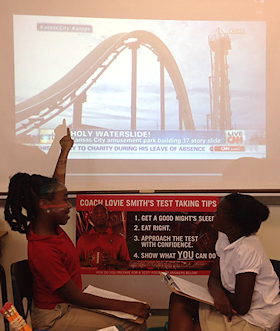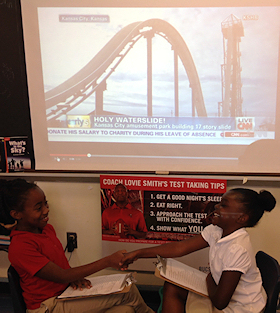 After recently finishing another round of standardized testing, as well as too many district-required assessments that mimic the standardized tests, I am inclined to look for additional ways to make assessments more meaningful and engaging for my students. Why? Because I struggle to watch some of my students sit through a multiple-choice test. Some of my students come to school after witnessing horrific crimes, after not eating breakfast, after engaging in fights (at home or on the street), and I have to get them to concentrate on—let’s just say it—a boring test that lasts way too long.
After recently finishing another round of standardized testing, as well as too many district-required assessments that mimic the standardized tests, I am inclined to look for additional ways to make assessments more meaningful and engaging for my students. Why? Because I struggle to watch some of my students sit through a multiple-choice test. Some of my students come to school after witnessing horrific crimes, after not eating breakfast, after engaging in fights (at home or on the street), and I have to get them to concentrate on—let’s just say it—a boring test that lasts way too long.
I never cared about those tests growing up. I specifically remember putting effort into maybe the first five questions on standardized tests and then bubbling in whatever because I just didn’t care. It wasn’t relevant to me.
Zoning out didn’t mean I didn’t understand what I learned or read—it just meant I didn’t care enough to pay attention. Daydreaming was just so much better. That being said, if I was assigned a project in grade school, I couldn’t STOP thinking about how I was going to make my project the best. Most of us can remember those projects where we pretended to be a president, or designed a commercial (basically what we would now call “performance tasks” minus a few of the critical elements).
Performance tasks seem to present problems for multiple reasons, including the time it takes to create one as well as design a rubric to match. There are also a lot of rules to designing performance tasks. And engaging performance tasks seem even harder to design for reading. I also need buy-in from my grade-level team so that we can look at the data and use it to guide further instruction.
Yet, even with all these obstacles, we must push on in order to gain meaningful data from our students.
So do you have to reinvent the wheel? No! Use the resources you have and think outside the box! Think of all the activities you create in the classroom and tweak them. For example, I recently read “Brain Powered Strategies to Engage All Learners” by LaVonna Roth. This book is full of strategies designed to engage the learner by reinforcing connections between the student and the subject matter without a worksheet.
After utilizing these strategies in my classroom, I began to adapt some of the activities into assessments. One strategy in particular I love to use as a form of assessment is called “That’s a Wrap.” In this strategy, students create their own study guide through a process that mimics an interview. My students were given an article from Scholastic’s about the new water slide opening in Kansas City, called Verrückt (German for “crazy”). After reading the article, students had to write down questions they had about the waterslide.
 Little did they know they all had very similar questions, validating that their questions were probably important ones: Is this ride safe? What if the riders fall out? Can they go down without a raft? How tall is it? Even crazier is that all of the questions they asked were answered in the text but after one read they weren’t picking up on those important details.
Little did they know they all had very similar questions, validating that their questions were probably important ones: Is this ride safe? What if the riders fall out? Can they go down without a raft? How tall is it? Even crazier is that all of the questions they asked were answered in the text but after one read they weren’t picking up on those important details.
I typed up all of the students’ questions and told them their task. Students were going to pretend to work at this park and be interviewed by the local media regarding the opening of this new water slide. They had to be prepared to answer the reporter’s open-ended questions. They needed supporting details to justifythe important points they were going to make. Where would the answers come from? The text, of course.
The possibilities here are really endless. You can tie in criteria for research and technology and encourage students to find videos and more articles related to the topic. This task could include speaking and listening standards as well as be used for almost any topic in all content areas. Imagine interviewing a hurricane for science! Another option: rather than have students create or fill in a timeline of someone’s life, they could be interviewed and discuss those moments in chronological order with an interviewer.
Here are some additional ideas for using performance tasks in the classroom:
- Ask students to create a restaurant menu for pets based on information they read in an article related to pet food. Have them create menu items based on a specific animal’s diet.This will show you that students are able to compare and contrast the diet of certain animals through the organization of their menu and whether or not they understood what they read.
- Invite students to create a Facebook page (using a template—there are tons of free options online!) for a book character, well-known historical figure, or a person in current events. Students could be required to read multiple sources of text and even watch videos.Depending on your teaching focus, examples of the criteria could be the following.
- Include four written status updates that represent how the character’s feelings change throughout the story.
- Include the character’s hometown.
- Include two status updates for setting changes.
- Include four friends of the character.List two people who were declined a friend request. (A writing piece could be added by having students provide a rationale for their friend choices and those who were denied.)
Wiggins and McTighe offer a great tool to assist in the creation of performance tasks in their book, “Understanding By Design,” using the acronym GRASPS (Goal, Role, Audience, Situation, Performance and Standards.) Here are some important things to remember as we design performance tasks:
- A performance task usually involves presenting students with a real life problem, where they develop a product or perform for an identified audience (real or simulated).
- Tasks should be relevant, relatable, and developmentally appropriate to the grade level and student.
- Engaging does NOT always mean it is effective.
- Teachers must set the learning outcomes first and be clear about the intended performance results!
- Think: what is the evidence we need to measure a student’s understanding?
- Collaborate with other teachers! We learn most from each other, so open up those doors and start talking to one another.
- Use the Internet to take advantage of so many great ideas already online. Check out Pinterest, TeachersPayTeachers, Facebook pages, and blogs.You may just find an idea you want to tweak.
In order for anyone to want to do anything, it has to hold value. Assessments must be meaningful as well. It’s hard for students to find little, if any, value in our standardized tests these days because the meaning lies within comparing schools, districts and states, as well as holding teachers accountable. But where is the value for the student? Where is the connection for the students? We want them to be creative, collaborative, and able to communicate. Bubbling in answers doesn’t allow for any of that.It’s not the content of these traditional tests that is bad; it’s the form and authenticity of them.
This is something we can change in our classrooms. As teachers, we have the power to make our students’ faces light up. We have the power to make their creativity come alive. We have the power to help them understand what real learning and problem solving looks like in the real world.
We are teachers. We not only have the power to make these changes, we have the tremendous responsibility to do so—and fast.
 Karen Jackson is a third grade teacher in Tampa, Florida. She has been a classroom teacher for over 12 years. She holds a Master’s Degree in curriculum, instruction and assessment. She is a professional development writer and trainer and owns an educational resource company that supplies resources and professional development for teachers around the country. You can find Karen at www.sharpenyoungminds.org.
Karen Jackson is a third grade teacher in Tampa, Florida. She has been a classroom teacher for over 12 years. She holds a Master’s Degree in curriculum, instruction and assessment. She is a professional development writer and trainer and owns an educational resource company that supplies resources and professional development for teachers around the country. You can find Karen at www.sharpenyoungminds.org.